Economy
Zimbabwe’s scrap metal rush creates a circular economy, and headaches for authorities – chinadialogue
In the city of Bulawayo, a struggling steel industry has in the past few years found relief in small-scale producers. These producers have contributed to a rush for scrap metal that has brought problems of its own, including a spike in vandalism and metal theft.
Steel manufacturing companies once thrived in Zimbabwe’s second city, which used to be celebrated as the nation’s industrial hub. But over the past decade, hundreds of companies have shut down in Bulawayo, citing high energy costs and water shortages, reducing the city’s once billowing furnaces to a silent wasteland of derelict structures. Pledges by the government to resuscitate industry have done little to help.
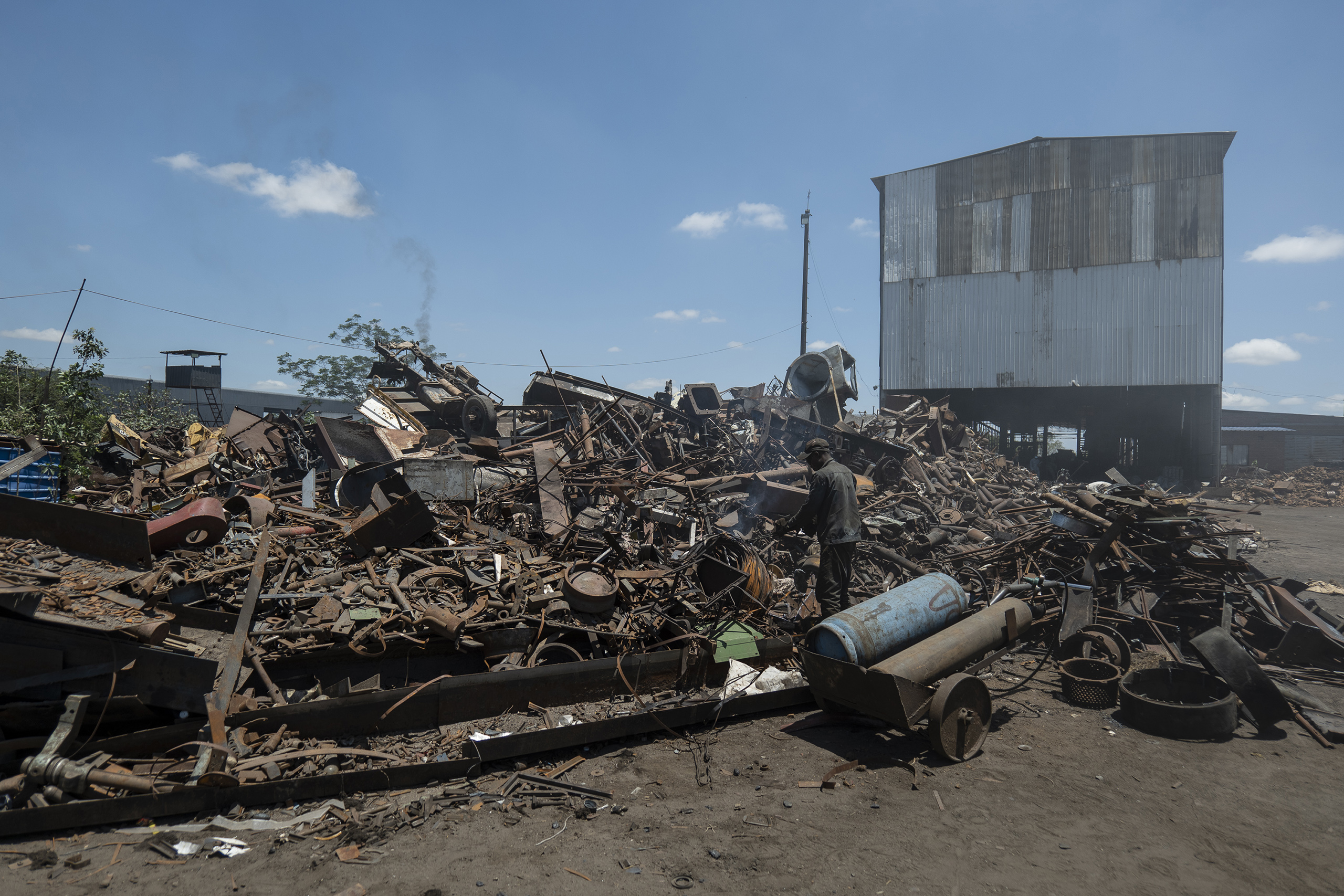
In recent years, small foundries and steel producers, including two owned by Chinese companies – Huamin Steel and Naisonale Investments – have set up in Kelvin West, an industrial area of the city where bargain hunters can source anything from car parts to coffins to a lunch consisting of cow heels.
Naisonale Investments, which employs about 150 workers, recycles scrap to supply steel products such as beams to the domestic construction sector. At peak output, the company produces 30 to 40 tonnes of steel per day, according to Pritchard Murayirwa, the general manager.
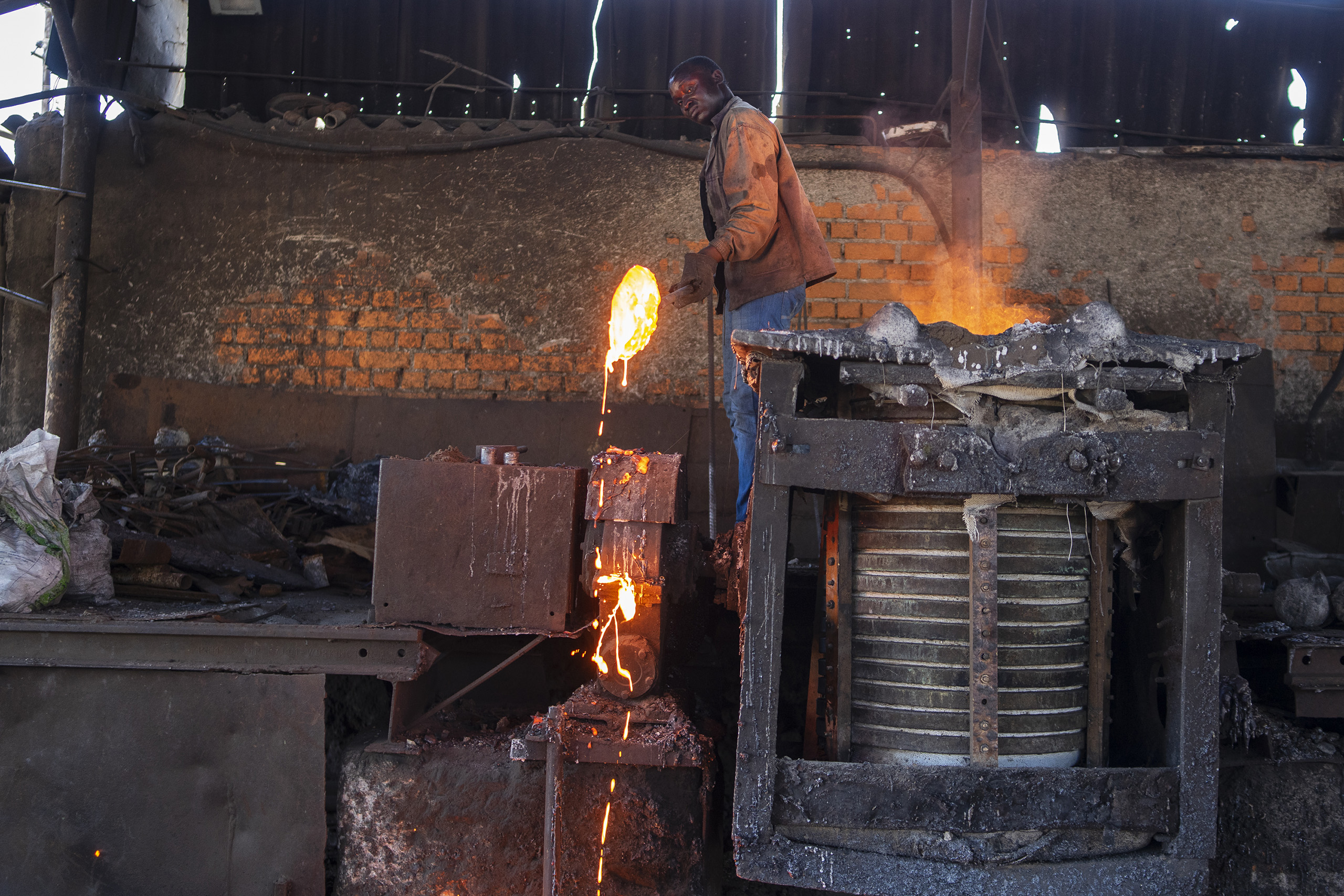
A tour of the company’s premises revealed a busy production cycle running 24 hours per day, in which scrap metal is sorted and prepared for the furnaces, ready to make new steel products. Steel is considered by the government to be a critical industry, so companies such as Naisonale have been exempted from the planned power outages which have crippled other industries in Zimbabwe. Their success has, however, caused headaches for other sectors in Bulawayo and the wider nation.
Increased steel crime
The growth in operations at steel companies such as Huamin and Nasionale has created strong demand for scrap steel, which may have inadvertently contributed to a rise in vandalism, including of state-owned enterprises such as the struggling National Railways of Zimbabwe (NRZ). Theft cost the railways more than US$3.5 million last year, according to Martin Banda, a company spokesperson.
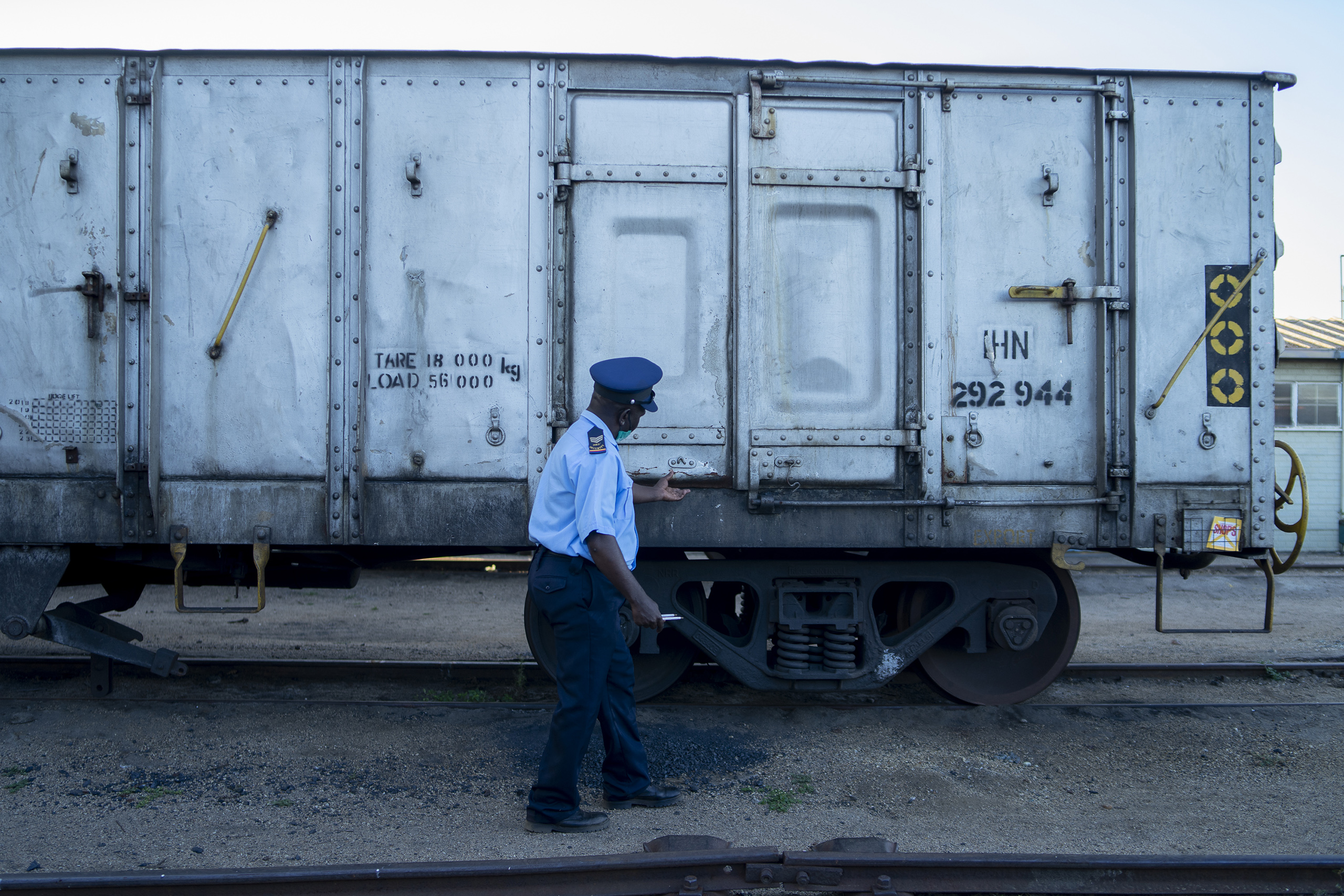
“The railways continue to lose infrastructure to vandalism and, from what we gather, the vandalised steel is sold to scrap yards where it is recycled and turned into other steel products,” Banda told China Dialogue.
It’s not only steel items that are being sought in this new rush for scrap. “Brass bearings in our trains are also being targeted because we are told brass handles are always in demand with funeral parlours for coffin handles,” Banda said.
There is a certain irony in the railway system falling victim to vandalism, as Judith Ncube, Bulawayo’s minister of state for provincial affairs, recently pointed out. “NRZ locomotives once transported key raw materials for the foundry sector,” she told a meeting of the Zimbabwe Institute of Foundries (ZIF) last month.

At the Naisonale Investments scrap heap, parts from haulage trucks and railways, such as tracks and train components, can be found, before they are transferred to the furnaces and cast into new steel products.
According to its manager, Murayirwa, a tonne of scrap metal sells for US$150, but dealers can get up to US$300 depending on the day’s market price.
“We get scrap from big companies, some of whom have abandoned their operations, but also from individuals who have scrap to sell. No one can say we are promoting vandalism,” said Murayirwa.
One scrap metal dealer located close to Naisonale Investments told China Dialogue he sells most of his scrap to the Chinese companies in Bulawayo. Some also goes to buyers in the small town of Kwekwe, a little over 200km southeast of Bulawayo and home to the perennially troubled state works, the Zimbabwe Iron and Steel Company, or Ziscosteel. Kwekwe has in recent years seen the establishment of several small foundries amid continuing efforts by the government to revive the steel sector.
In a country where, according to international aid agencies, millions survive on less than a dollar a day, scrap metal collection has emerged as a potential source of income. But while this presents an economic lifeline for many, the prices offered for scrap by new companies in the domestic steel sector appear to have provided an incentive for vandalism and theft.
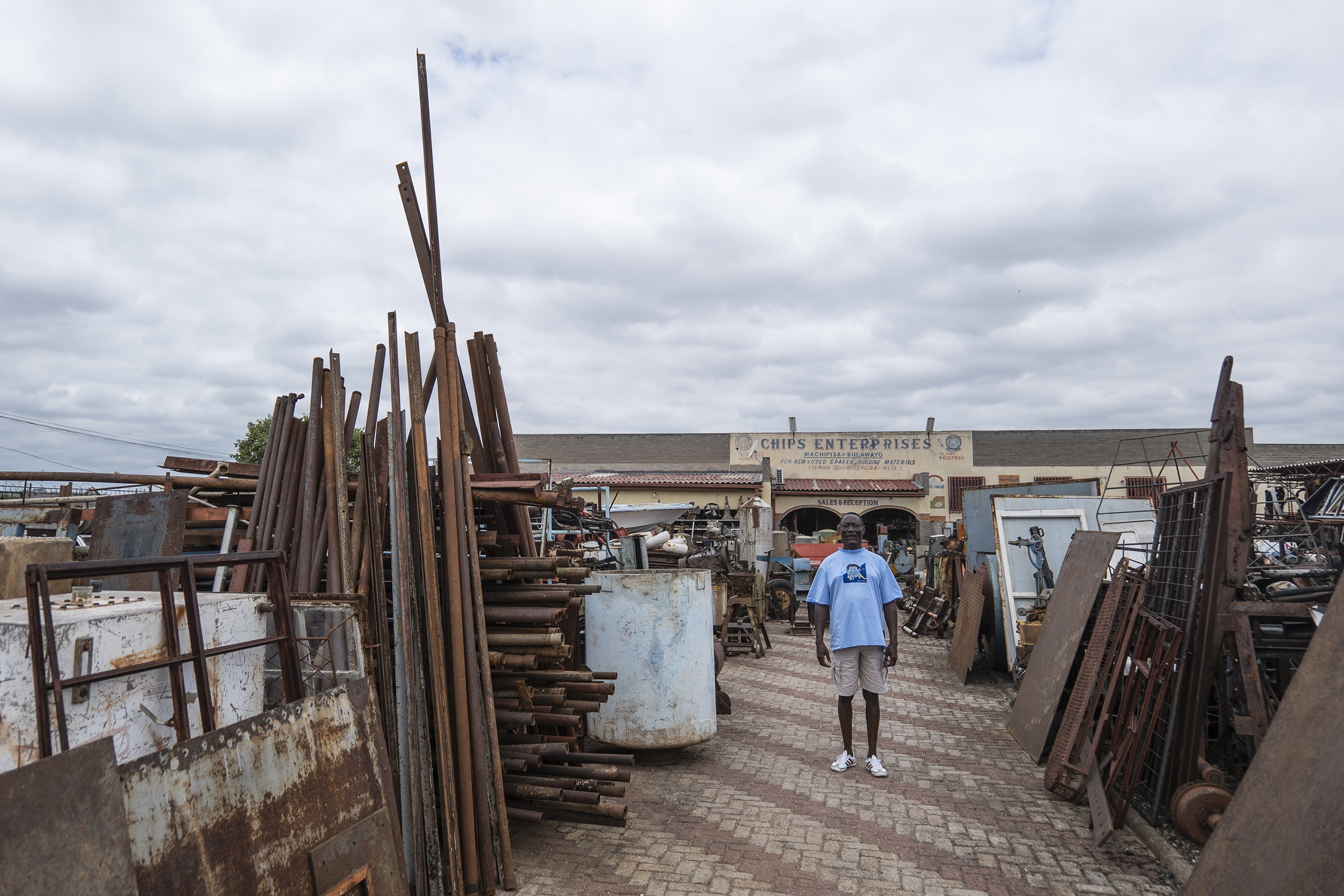
Local industry leaders have also complained about the government issuing permits to companies that allow them to export scrap metal to neighbouring countries, and circumvent an official but loosely enforced ban. Illegal exports by unlicensed dealers also present a significant problem. These leakages, sanctioned or otherwise, deprive the domestic industry of much needed materials, and may have caused Zimbabwe losses as high as US$5 billion over the past two decades, according to the country’s mining minister.
The fluctuating availability of scrap metal presents challenges that exports only aggravate, according to Itai Zaba, president of the ZIF. He is clear about the action needed: “We want a [total] ban on exports, to supply local demand.”
Like Minister Judith Ncube, Zaba also notes the particular difficulties faced by the railway industry, whose parts were made in foundries, which has been “cannibalised” by scrap theft.
According to local media reports, vandalism of everything from transport parts to power and telephone infrastructure has likely cost the country many millions of dollars, amid a host of economic and political challenges over the past two decades.
Backyard workshops
Zimbabwe’s downward economic spiral has led to an unintended circular economy where anything from plastic bottles to soda cans now provide a source of income. Amid the uncertainty about supply of steel and related alloys, small-scale metal workers have found ways to create a living for themselves, in a country where millions are jobless.

Lowani Ncube, who makes aluminium pots at one of the thriving informal backyard workshops in Bulawayo’s Renkini area, says he buys and melts scrap from car breakers.
“The Chinese businesses who operate in the city deal with heavy metal that requires a lot of electricity [to melt],” he told China Dialogue. “For small metal workers like us, we melt our scrap using coal.”
While larger businesses such as the city’s Chinese-owned operators work with larger items, backyard workers such as Ncube largely deal in smaller goods. “I use soda cans which I buy from collectors and melt them to make three-legged pots,” he told China Dialogue from his workshop. Across the city, local residents can be found digging through commercial waste looking for discarded soda cans.
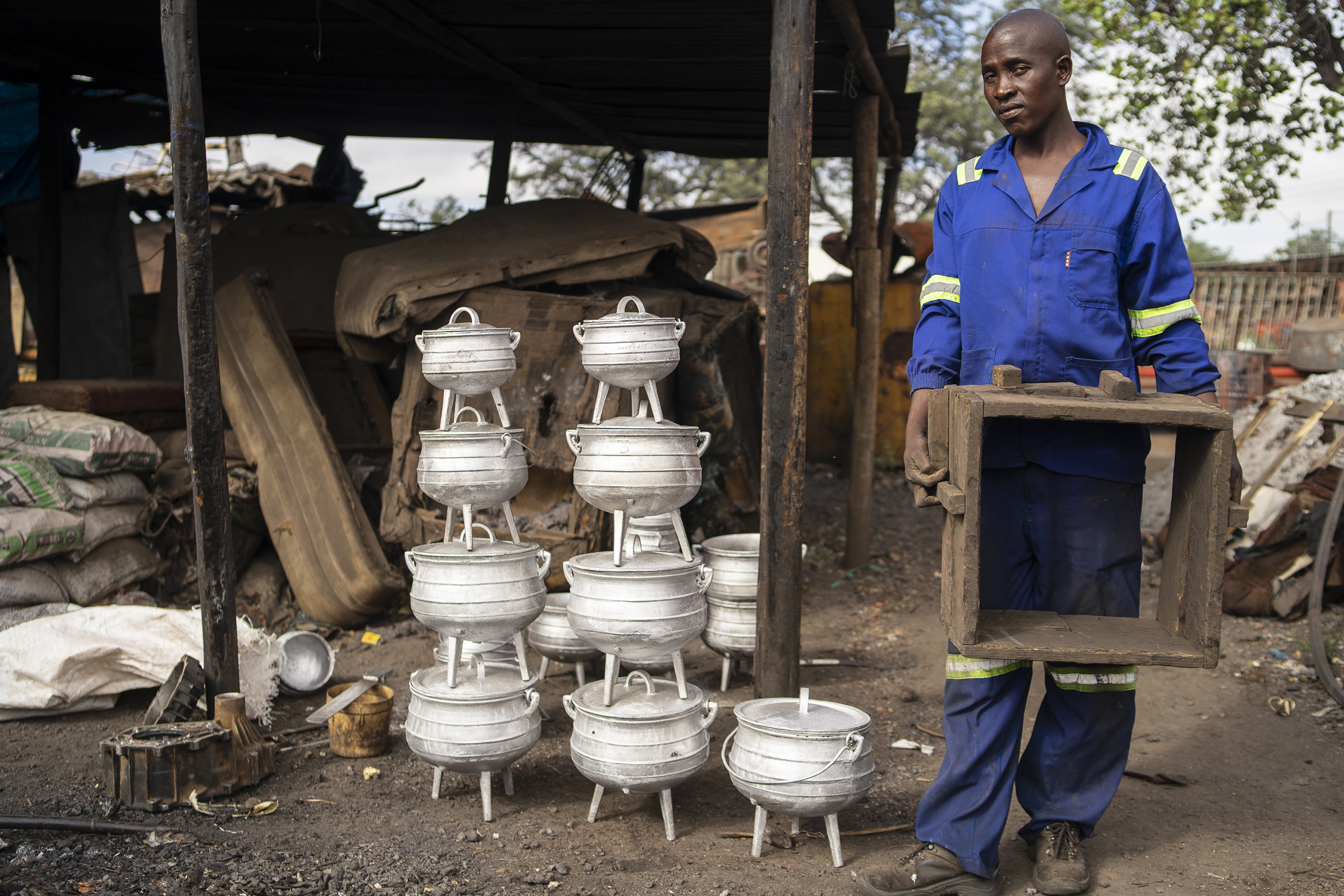
Just around the corner from Ncube’s workshop, 27-year-old Kumbirai Siziba can be found working on tough steel products such as pick-axe heads. His methods are more traditional: using blacksmith muscle, and with the assistance of a group of other workers, he melts iron scrap using coke, then bangs it into shape to make a variety of products.
“We buy the scrap from people who go around collecting it for resale, while we get the coke collected from a Zimbabwe Electricity Supply Authority [the country’s power utility] dump site,” Siziba told China Dialogue. His workshop is a far cry from the industrial-scale output of other steelmakers in the city, but is still a part of a growing trade attracting ever increasing numbers of the city’s residents.
Reviving a steel sector in decline
Zimbabwe used to be one of southern Africa’s biggest steel producers until Ziscosteel shut down its production more than a decade ago. At its peak, Ziscosteel employed more than 5,000 workers.
Although the company has long been beset by instability and management issues, its absence costs the Zimbabwean economy. Last year, Sekai Nzenza, the country’s minister of industry, complained that, following the closure of Ziscosteel plants and the drop in domestic production, steel imports to support local industry were costing the nation more than US$1 billion a year.
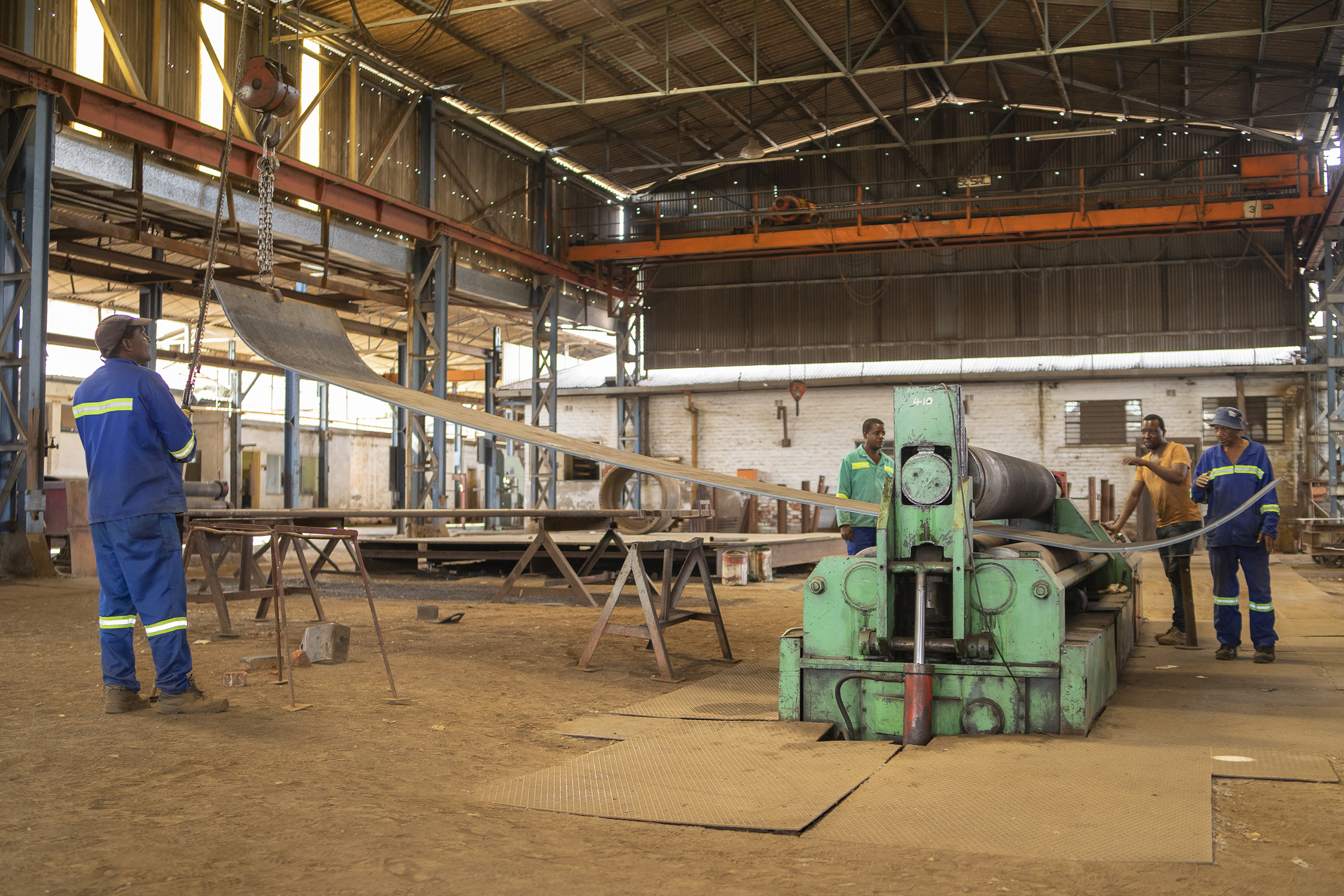
The government has made successive attempts to resuscitate the majority state-owned company but with limited success. The latest attempt to revive the steel works was in April last year, when the company’s board announced it was looking for new investors.
Aside from Ziscosteel, production in Zimbabwe does continue, but the steel industry is a shadow of its former self. According to Dosman Mangisi, chief operating officer of the ZIF, there are now a total of 55 foundries operating in the country, of varying size and capacity, which process over 340,000 tonnes of scrap annually.
“We are however operating below capacity, at 40%, because of operational challenges that include high rentals and shortage of raw materials,” Mangisi said, adding that the sector contributes more than US$1.5 billion to the national economy annually.
Elsewhere, several domestic and international companies have stepped in to revive large-scale steel-making in the country. Tsingshan Holding Group, one of China’s largest corporations and a major global producer of stainless steel, is investing heavily in iron ore and coke production in Zimbabwe, as well as a steel plant that alone is worth more than US$1 billion. It will become the country’s largest steel-making enterprise, and should create hundreds of jobs.
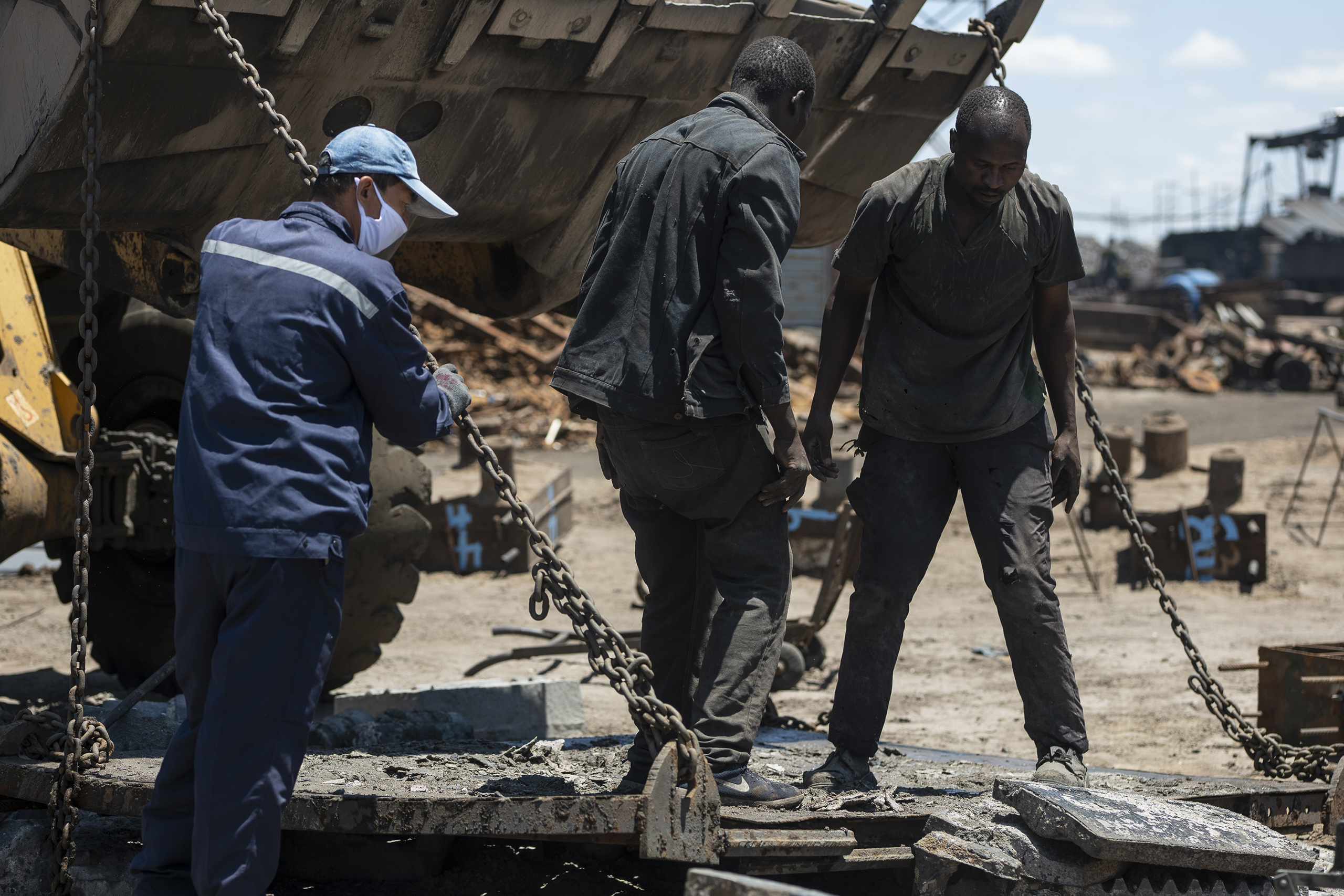
No timeline has been offered as to when Tsingshan’s new operations will start, but according to statements issued by company officials in March last year, the plant will have capacity to produce 1.2 million tonnes of steel under its subsidiary Zhejiang Dinson Holdings, which already runs a ferrochrome plant in Zimbabwe.
ZIF could not provide the number of Chinese foundries operating both in the city of Bulawayo and across the country, but Mangisi told China Dialogue they are in the process of preparing an inventory that will detail the foreign investors involved in the sector, including the Chinese entities.
The impacts of these new investments in large-scale steel-making in Zimbabwe will become clearer in time, but it may bring a boost to a currently moribund sector. A return to more reliable steel output and its potential associated economic benefits, as well as the creation of jobs in the industry, could provide a stability that may steady the rush for scrap metals. However, with an increasing number of people making their livelihood in scrap collection, the situation will also require careful management.
Economy
Bobby Kennedy And The Ownership Economy – Forbes


In recent decades, populist presidential campaigns have arisen from the left (Bernie Sanders) and the right (Pat Buchanan). Both of these campaigns had limited appeal across the political spectrum or even attempted to engage Americans of diverse political views.
Over the past year in his independent presidential campaign, Bobby Kennedy Jr. has sought to bring together members of both major political parties, with a form of economic populism that expands ownership opportunities. In contrast to Sanders, Kennedy’s goal is not to grow the welfare state or state control over the economy. His economic populism is free-market oriented, aimed at building a broader property-owning middle class. It is aimed at widening the number of worker-owners with a stake in the market system, through their ownership of homes, businesses, employee stock and profit sharing, and other assets.
Whether Kennedy’s economic strategies can achieve the goals of ownership and the middle class he has set, remains to be determined. But his “ownership economy” is one that should be discussed and debated. Currently, it is largely ignored by the legacy media—or subsumed by the parade of articles speculating about of how many votes he will “take away” from President Biden or President Trump.
I wrote about Kennedy’s heterodox jobs program late last summer. In the eight months since, he has sharpened his jobs agenda, and connected it to a broader platform of worker ownership. It is time to revisit the campaign’s economic themes, briefly noting three of the subjects Kennedy often speaks about in 2024: the abandonment of vast sections of the blue collar economy, low wage workforces, and the marginalization of small businesses.
Abandonment Of Blue Collar Economy
“Compensate the losers” is the way that political scientist Ruy Teixeira characterizes the Democratic Party approach to the blue collar economy since the 1990s. According to this approach, workers whose jobs are impacted by environmental policies (oil and gas workers) or trade polices (heavy manufacturing workers) will be retrained for jobs in the green economy or in advanced manufacturing or even as white collar fields like information technology (the oil worker as coder). Since the 1990s a vast network of dislocated worker programs and rapid-response programs have arisen and are prominent under the Biden administration.
As might be expected, retraining hasn’t proved so easy in practice. One example: here in Northern California, the Marathon Oil
MRO
refinery closed in October 2020, laying off 345 workers. The federal and state government immediately came in with the union offering a range of retraining and job placement services. A study by the UC Berkeley Labor Center found that even a year after closure, a quarter of the workers were still unemployed. Those that were employed earned a median of $12 less than their previous jobs. Other studies similarly have identified the gap between theories of skills transference and re-employment and the realities for most blue collar workers—including the realties of alternative energy jobs today that usually pay considerably less than oil and gas jobs.
Each refinery closure or plant closure has its own business dynamics, and in many cases, like the Marathon Oil refinery, the facility will not be able to avoid closing. Re-employment cannot be avoided. Kennedy has spoken of improving the re-training and re-employment process for laid off workers, implementing best practices in retraining with the participation of unions and worker organizations.
function loadConnatixScript(document)
if (!window.cnxel)
window.cnxel = ;
window.cnxel.cmd = [];
var iframe = document.createElement(‘iframe’);
iframe.style.display = ‘none’;
iframe.onload = function()
var iframeDoc = iframe.contentWindow.document;
var script = iframeDoc.createElement(‘script’);
script.src = ‘//cd.elements.video/player.js’ + ‘?cid=’ + ’62cec241-7d09-4462-afc2-f72f8d8ef40a’;
script.setAttribute(‘defer’, ‘1’);
script.setAttribute(‘type’, ‘text/javascript’);
iframeDoc.body.appendChild(script);
;
document.head.appendChild(iframe);
loadConnatixScript(document);
(function()
function createUniqueId()
return ‘xxxxxxxx-xxxx-4xxx-yxxx-xxxxxxxxxxxx’.replace(/[xy]/g, function(c) 0x8);
return v.toString(16);
);
const randId = createUniqueId();
document.getElementsByClassName(‘fbs-cnx’)[0].setAttribute(‘id’, randId);
document.getElementById(randId).removeAttribute(‘class’);
(new Image()).src = ‘https://capi.elements.video/tr/si?token=’ + ’44f947fb-a5ce-41f1-a4fc-78dcf31c262a’ + ‘&cid=’ + ’62cec241-7d09-4462-afc2-f72f8d8ef40a’;
cnxel.cmd.push(function ()
cnxel(
playerId: ’44f947fb-a5ce-41f1-a4fc-78dcf31c262a’,
playlistId: ‘4ed6c4ff-975c-4cd3-bd91-c35d2ff54d17’,
).render(randId);
);
)();
Manufacturing jobs as a share of total jobs have been in decline for the past four decades, and even as he urges trade policies for reshoring jobs, Kennedy recognizes that manufacturing going forward will be a limited part of the blue collar economy. The blue collar jobs of the future will increasingly be in the trades and services. Kennedy has enlisted “Dirty Jobs” host Mike Rowe to highlight the importance of the trades, and identify policies that can improve conditions and wages for the trades. Among these policies: a greater share of the higher education federal budget redirected from colleges into training in the trades, and support for the workers who seek to enter and remain in the trades.
Improving the economic position of blue collar workers also means expanding employee stock ownership and profit sharing. While worker cooperatives have failed to gain traction in America, forms of employee stock ownership and profit sharing are being implemented in companies with significant blue collar workforces, such as Procter & Gamble
PG
, Southwest Airlines
LUV
and Chobani. Kennedy poses the challenge: Let’s have workers-as-owners more fully share in the economic success of their employers.
Inflation Impact On Low Wage Workers
In nearly all of his talks on the economy, Kennedy addresses the issue of affordability, and how inflation has undercut wages of America’s lower wage workforces. He posts regularly on the increased cost of food, transportation, and housing, the financial strains on working class and middle class families, the number of workers who live paycheck to paycheck. When the March national jobs report was issued earlier this month, he noted the slowdown in year-over wage growth (at 4.1% the lowest year-over increase since 2021) and the increase in part-time jobs.
Kennedy recognizes that many of the low wage workforces are in such sectors as long-term care, retail, and hospitality, in which profit margins for employers are tight, and employers have limited flexibility individually to raise wages. Kennedy continues his calls for a higher minimum wage, reducing health care costs, strengthening protections and benefits for workers in the gig economy. He urges a reconsideration of trade and tax policies and the need for immigration policies that secure the nation’s borders. Kennedy’s strict border policies reflect both the “humanitarian crisis” he sees with the drug cartels and migrants, as well as the impact of unchecked immigration on the wages of low wage service and production workers.
Home ownership has a special place in Kennedy’s ownership economy, as part of bringing more workers into the middle class, and he has stepped up his advocacy on home ownership. Across society, widespread home ownership stabilizes communities, promotes civic involvement, serves as a hedge against social disorders.
Small And Independent Businesses
During the pandemic, Kennedy warned that economic lockdowns were devastating the small business economy. Today, in a regular series of podcasts on small business, he highlights the ongoing small business struggles. Just this past week, the National Federation of Independent Business, the nation’s largest small business organization, released a survey showing small business optimism is at its lowest level since 2012.
As with home ownership, Kennedy characterizes widespread small business ownership in terms of the social values as well as the values to the individual owners. Small business drives enterprise and service to others, in providing goods and services that customers value and will pay for. It drives job creation, including for individuals who do not fit easily into larger employment venues. A Kennedy Administration will prioritize rebuilding the small business economy, particularly in rural and inner city communities.
Kennedy’s small business agenda goes beyond a laundry list of small business grant and loan programs. As with the wage question, Kennedy seeks to tie a vibrant small business economy to underlying trade and tax policies. He also seeks to tie this economy to reforms in federal government procurement policies, which he describes as ineffectual.
Economic Challenges And Alternatives
The middle class society and economy of the 1950s that Kennedy grew up in and is central to his worldview was the product of unique economic forces and America’s dominant position in the post-World War II period. There is no way to get back to it, and recreating it will be more difficult than in the past, in the now global economy, and with rapidly advancing technologies.
But a broad middle class of worker-owners, is the right goal, and private sector ownership the right approach. People may find Kennedy’s strategies insufficiently detailed or unrealistic or even counterproductive. But Kennedy raises thoughtful challenges and alternatives to the economic platforms of the two main parties—just as he is raising serious challenges on a range of other issues.
Economy
Biden's Hot Economy Stokes Currency Fears for the Rest of World – Bloomberg


As Joe Biden this week hailed America’s booming economy as the strongest in the world during a reelection campaign tour of battleground-state Pennsylvania, global finance chiefs convening in Washington had a different message: cool it.
The push-back from central bank governors and finance ministers gathering for the International Monetary Fund-World Bank spring meetings highlight how the sting from a surging US economy — manifested through high interest rates and a strong dollar — is ricocheting around the world by forcing other currencies lower and complicating plans to bring down borrowing costs.
Economy
Opinion: Higher capital gains taxes won't work as claimed, but will harm the economy – The Globe and Mail
Canada’s Prime Minister Justin Trudeau and Finance Minister Chrystia Freeland hold the 2024-25 budget, on Parliament Hill in Ottawa, on April 16.Patrick Doyle/Reuters
Alex Whalen and Jake Fuss are analysts at the Fraser Institute.
Amid a federal budget riddled with red ink and tax hikes, the Trudeau government has increased capital gains taxes. The move will be disastrous for Canada’s growth prospects and its already-lagging investment climate, and to make matters worse, research suggests it won’t work as planned.
Currently, individuals and businesses who sell a capital asset in Canada incur capital gains taxes at a 50-per-cent inclusion rate, which means that 50 per cent of the gain in the asset’s value is subject to taxation at the individual or business’s marginal tax rate. The Trudeau government is raising this inclusion rate to 66.6 per cent for all businesses, trusts and individuals with capital gains over $250,000.
The problems with hiking capital gains taxes are numerous.
First, capital gains are taxed on a “realization” basis, which means the investor does not incur capital gains taxes until the asset is sold. According to empirical evidence, this creates a “lock-in” effect where investors have an incentive to keep their capital invested in a particular asset when they might otherwise sell.
For example, investors may delay selling capital assets because they anticipate a change in government and a reversal back to the previous inclusion rate. This means the Trudeau government is likely overestimating the potential revenue gains from its capital gains tax hike, given that individual investors will adjust the timing of their asset sales in response to the tax hike.
Second, the lock-in effect creates a drag on economic growth as it incentivizes investors to hold off selling their assets when they otherwise might, preventing capital from being deployed to its most productive use and therefore reducing growth.
Budget’s capital gains tax changes divide the small business community
And Canada’s growth prospects and investment climate have both been in decline. Canada currently faces the lowest growth prospects among all OECD countries in terms of GDP per person. Further, between 2014 and 2021, business investment (adjusted for inflation) in Canada declined by $43.7-billion. Hiking taxes on capital will make both pressing issues worse.
Contrary to the government’s framing – that this move only affects the wealthy – lagging business investment and slow growth affect all Canadians through lower incomes and living standards. Capital taxes are among the most economically damaging forms of taxation precisely because they reduce the incentive to innovate and invest. And while taxes on capital gains do raise revenue, the economic costs exceed the amount of tax collected.
Previous governments in Canada understood these facts. In the 2000 federal budget, then-finance minister Paul Martin said a “key factor contributing to the difficulty of raising capital by new startups is the fact that individuals who sell existing investments and reinvest in others must pay tax on any realized capital gains,” an explicit acknowledgment of the lock-in effect and costs of capital gains taxes. Further, that Liberal government reduced the capital gains inclusion rate, acknowledging the importance of a strong investment climate.
At a time when Canada badly needs to improve the incentives to invest, the Trudeau government’s 2024 budget has introduced a damaging tax hike. In delivering the budget, Finance Minister Chrystia Freeland said “Canada, a growing country, needs to make investments in our country and in Canadians right now.” Individuals and businesses across the country likely agree on the importance of investment. Hiking capital gains taxes will achieve the exact opposite effect.
-
Media17 hours ago
DJT Stock Rises. Trump Media CEO Alleges Potential Market Manipulation. – Barron's
-
Media19 hours ago
Trump Media alerts Nasdaq to potential market manipulation from 'naked' short selling of DJT stock – CNBC
-
Investment18 hours ago
Private equity gears up for potential National Football League investments – Financial Times
-
Real eState10 hours ago
Botched home sale costs Winnipeg man his right to sell real estate in Manitoba – CBC.ca
-



 Sports22 hours ago
Sports22 hours ago2024 Stanley Cup Playoffs 1st-round schedule – NHL.com
-
News16 hours ago
Canada Child Benefit payment on Friday | CTV News – CTV News Toronto
-
Business18 hours ago
Gas prices see 'largest single-day jump since early 2022': En-Pro International – Yahoo Canada Finance
-
Art21 hours ago
Enter the uncanny valley: New exhibition mixes AI and art photography – Euronews





